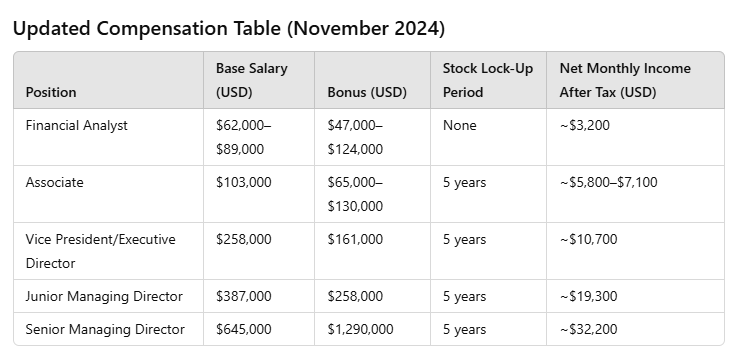The Truth Behind Investment Banking: What It's Really Like to Be an Investment Bank Trader Today
The investment banking world has long been romanticized in movies, television, and popular culture. From the high-flying antics of Gordon Gekko in Wall Street to the modern excesses portrayed in The Wolf of Wall Street, many people view investment banking as a path to untold riches, power, and an extravagant lifestyle. But is this portrayal accurate today? In reality, the life of an investment bank trader is far less glamorous, and the pressures, job instability, and intense hours create a career that’s challenging in ways most people wouldn’t expect.
Today’s investment bank traders are indeed highly paid, but their day-to-day experience is very different from what’s portrayed on screen. Long hours, fierce competition, strict corporate policies, and locked-up bonuses shape their work lives, often limiting the freedoms that the role appears to promise. This article dives into the real structure of investment banking pay, lifestyle, and career progression to reveal what being a trader actually entails in 2024.
The Myth of Instant Wealth and Prestige
In the movies, the lives of investment bankers appear easy, luxurious, and fast-paced. They seem to earn high salaries and million-dollar bonuses effortlessly, with minimal risk of ever losing their jobs. But today’s investment banking industry looks quite different. Economic changes, evolving regulations, and automation have transformed the landscape, making competition fiercer and job security shakier. In fact, modern investment banking is more about corporate structures and digital platforms than spontaneous trades and bold market moves.
Key Changes in the Industry
The Economist recently reported that the number of roles in trading desks has dropped by around 80% over the past two decades due to automation. Computers and algorithms now handle many tasks once managed by traders, significantly reducing the demand for human capital. As a result, the field is hyper-competitive, with around 10,000 applicants vying for each position at major banks, up from 2,000-3,000 applicants per role just 15 years ago.
Additionally, today’s investment bankers operate in a highly regulated environment. The 2008 financial crisis led to regulatory reforms worldwide, introducing stricter rules on trading and risk management. The compliance burden on investment banks has increased significantly, making today’s bankers less able to make rapid, high-risk trades without layers of approval.
Entry-Level Reality Check: Financial Analyst
The typical entry point for an investment banking trader is the Financial Analyst role. Entry-level analysts do earn impressive salaries by the standards of most other jobs, but the lifestyle is far from the luxurious image in movies.
Salary & Bonus
The starting salary for an entry-level analyst in 2024 ranges from $62,000 to $89,000. This might sound like a lot, but considering the high cost of living in cities like London and New York, it barely stretches far enough to cover basic expenses. Bonuses can range from $47,000 to $124,000 for top performers, but only a small percentage of analysts receive bonuses at the higher end of that range. Additionally, a portion of the bonus may be awarded in company stock, which is often locked up for several years.
Contract Terms
Most new analysts are hired on two-year contracts, and only the top performers will be offered a permanent role after that period. This temporary contract means that job security is shaky from the start, with many analysts finding themselves competing for a new role when their contract ends.
The Lifestyle
Far from the high-rise apartments and fast cars seen in movies, entry-level analysts often struggle to live independently in cities like London, where rental prices are among the highest in the world. With a net monthly income of around $3,200 after taxes, many analysts find themselves in shared housing arrangements and are often too busy to enjoy any semblance of a social life. Long hours, often exceeding 80 hours per week, are the norm. Weekend and evening work are common, leaving little time for personal activities or relationships.
Promotion to Associate: More Responsibility, but at a Cost
If an analyst manages to excel during their first two years, they might be promoted to Associate, bringing a significant salary bump to $103,000 with bonuses ranging from $65,000 to $130,000. Yet the increased pay comes with even higher expectations and responsibilities.
The Catch: Stock Lock-Up Period
Associates face the “golden handcuffs” phenomenon, where a significant portion of their bonus is awarded in company stock. These stock bonuses are locked up for five years, meaning associates cannot access this part of their compensation until they’ve spent half a decade with the company. If they leave the company, whether voluntarily or involuntarily, they forfeit these shares. This creates a powerful incentive to stay, but it also limits their freedom and forces them to remain even when work conditions become grueling.
Living on $5,800–$7,100 Monthly
Associates may feel wealthier with a monthly income of $5,800 to $7,100 after taxes, but this income must cover high rent, transportation, and food costs. While they may now be able to afford a one-bedroom apartment or a nicer shared space, Associates still live far from the lifestyles portrayed in Hollywood. Much of this income goes toward basic living expenses and student loan repayments.
Climbing Higher: Vice President and Executive Director – High Salary, High Stakes
For those who survive the Associate level, the next position is Vice President (VP) or Executive Director. At this point, the base salary reaches $258,000, with bonuses around $161,000. The compensation sounds significant, but the lifestyle and work environment become even more challenging.
Lifestyle and Workload
Vice Presidents are responsible for overseeing teams and managing high-value accounts. They’re expected to work long hours, often exceeding 70 hours per week. The stress of managing a team and meeting performance targets means that the role can be mentally and emotionally taxing. High pay comes at the cost of personal time, and many VPs report feeling overwhelmed by the demands of their job.
After-Tax Realities
Despite the high base pay, VPs may only take home around $10,700 per month after taxes. With the ongoing lock-up of a portion of their bonuses in company stock, VPs may feel financially “stuck,” having to stay with the company for years to access their full earnings.
Junior Managing Director: High Pay, High Expectations
If a VP continues to perform at a high level, they may eventually become a Junior Managing Director, with a base salary of $387,000 and a $258,000 bonus. By this point, a large portion of the bonus is awarded as stock, and the company imposes a five-year lock-up.
Freedom Sacrificed for Income
Junior Managing Directors have more financial security, but at this stage, they are deeply embedded in the company, both financially and professionally. They are responsible for large portions of the business, and their day-to-day life revolves around the company’s success. The demanding hours and high expectations create a work-life imbalance that can lead to burnout and health issues.
The Elusive Senior Managing Director: Few Make It, and the Lifestyle is Restrictive
The final tier in the hierarchy is the Senior Managing Director, with a base salary of $645,000 and bonuses reaching $1.29 million. This is the level where individuals can achieve significant financial freedom—if they are able to maintain their position and performance.
Odds of Success
Only a tiny fraction of analysts make it to this level. Statistically, less than 1% of those hired as entry-level analysts reach Senior Managing Director. The road to this role is filled with intense competition, long hours, and job insecurity, making it a rare achievement.
The Reality of Life as a Senior Managing Director
While this position offers financial security, many find that their personal lives are sacrificed. With stock bonuses still locked up and the high expectations for leadership, Senior Managing Directors remain heavily committed to the company. Despite the high income, the long hours and intense responsibilities leave many unable to enjoy the lifestyle that Hollywood portrays.
The Hidden Costs of an Investment Banking Career
For those who are inspired by movies to pursue a career in investment banking, here are some critical factors to consider:
The Golden Handcuffs: Stock lock-up periods mean that a significant portion of compensation is inaccessible for five years. Leaving the company means forfeiting those shares, which can represent a considerable loss in potential earnings.
High Taxes: Salaries may seem substantial, but high tax rates significantly reduce actual take-home pay. For instance, a VP’s $258,000 salary results in about $10,700 per month after taxes and stock lock-up adjustments.
Lifestyle Constraints: Even high earners often live relatively modest lifestyles due to high urban living costs, ongoing stock restrictions, and extended work hours.
Job Instability: With technological advances and shifts in the financial industry, job security is lower than ever, especially for those starting out on temporary contracts.
Low Odds of Reaching the Top: While movies may portray it as easy to climb the corporate ladder, only a tiny fraction of those who start in investment banking ever reach the senior ranks. For most, the journey is long and exhausting, with intense demands and limited rewards.





